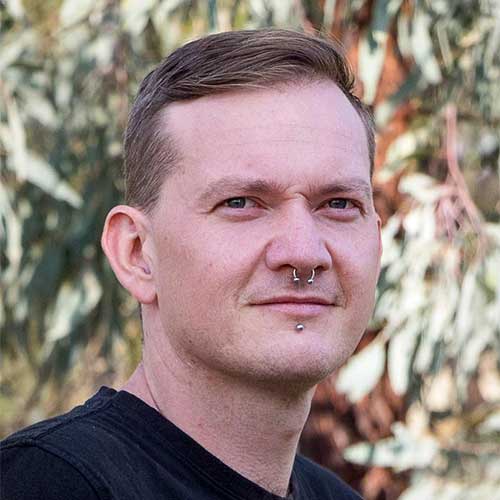If you were asked to define ‘the arts’, what would you say? No doubt most of us would rattle off the theatre, galleries, concerts, writing, painting and sculpting. Some would include film, music, dance, and perhaps even gardening and cooking.
But Charles Sturt University’s Christopher Orchard, Sub Dean, Academic, for the Faculty of Arts and Education challenges us to expand our definition. And when we do, he says, we’ll have a much better understanding of why the arts matter in Australia.
“In Australia we tend to break it up into two categories: creative services and cultural production. Creative services include those things that are fee-for-service like copy writing, architecture, graphic design and software engineering. Cultural production is really quite broad and incorporates all forms of performing arts and visual arts.”
So why are the arts so valuable to regional Australia? Christopher gives us six reasons.
#1: The arts underline so much of what we do.
With Christopher’s two-pronged definition – creative services and cultural production – it becomes clear that art is all around us.
“We are starting to acknowledge that creativity is one of those soft skills of the future that everyone’s going to need.
“It will become increasingly important that the arts underline everything we do. Because it’s in the arts where we prototype, test things, throw out what doesn’t work and move towards ‘better’, rather than just thinking there is one solution.
“That’s an arts way of working. Trial, error and discovery. The capacity to not get stuck in a rut, of thinking the one thing you’ve done is perfect. It’s important to have someone else test it for you by putting it out there and getting feedback.
“Having that capacity is going to be hugely important for the future workforce. We are continuing to move towards more people being self-employed and that requires a certain level of entrepreneurial capacity and attitude.
“I’ve always said artists are fantastic entrepreneurs – they just don’t recognise it! Consider this, artists have early stage ideas, they often go and pitch them to galleries, book publishers, performance companies or museums – who either invest in seeing the concept worked up into an exhibition, publication or performance, or not.
“And, if an artist isn’t successful, they have to pivot in their practice and try again. That is entirely the entrepreneurial journey. It is also about being resilient.”
#2: Liveability!
When you live in a regional area you know you’ve got the best of both worlds: city living wrapped in country hospitality. But to maintain vibrant regional living, Christopher explains, these areas need more than professionals and facilities – they must address the cultural production aspect of our definition.
“While it’s important for regional areas to have other drawcards, the arts makes places more liveable – and encourages people stay in these areas.
“You can have all the monetary incentives in the world to bring a doctor to your region, but you need other incentives to make people stay. If you’re in a faceless community where all you’re doing is earning money, eventually you’ll want to leave because you’re not being fulfilled as a human being.
“Places that have thriving creative practitioners – shows, performances and venues that mix the metro blockbusters with regional input – are more liveable. If councils are looking to retain talent – medical, executive, etc. – having good arts policies is absolutely critical.”
#3: Telling our stories
Regional arts usually has two elements: major metropolitan works being toured and telling regional stories. And while the major works are often billed as the big drawcards, Christopher believes promoting the Australian regional identity – locally and then on the world stage – is paramount.
“Telling regional stories is incredibly important to me, because I’m based at Charles Sturt.

“We must continue to produce internationally significant exhibitions and performances that tell the quintessential Australian stories and speak to our changing national identity. Stories told by us, not to us.”
Christopher Orchard
#4: Diversity
The arts – in all its diverse incarnations – has always been wonderfully inclusive.
“In terms of accommodating diverse practices, the arts is a place where multiple Australian identities can shine. This inclusive environment allows us to air, in a safe space, diverse views from which we can grow and share.”
#5: Mental health
Remember William W. Purkey’s words: You’ve gotta dance like there’s nobody watching… and sing like there’s nobody listening.
Participating in the arts is good for the mind and soul.
“Arts has a major role to play in health. Whether it’s dance, music, painting, performing, sculpture, or photography – they can all have an important impact on therapy. They help minds, and bodies, heal.”
#6: The economy
Artists in the creative industries contribute greatly to the domestic revenue of any area. Best of all? Artists are a renewable resource!
“Their brains are the resource. As long as an artist is having new creative thoughts then the resource is there.
“Many regional centres rely on tourism for their continued survival. Cultural tourism is a massive part of the Australian economy and is increasing its market share as we see the end of traditional manufacturing.”
The future of regional Australia
Arts clearly contributes much to the fabric of regional communities. If we want those communities to continue to thrive, Christopher believes we need to re-evaluate the role regional arts plays.
“As we look towards the future, with automation or increasingly high-tech manufacturing, people who work with their hands and their head, like artists, are going to be incredibly important. That’s because their unique thoughts are very hard to replicate with automation or artificial intelligence.”
Put simply: they are hard to replace.
“It will also be critical for governments to look at the arts in regions as a way of building capacity. We need some discussion from local, state and federal government about policy implications and investments in the regions as creative spaces. Whether that means the activation of special creative precincts or diversifying the Australian film industry to include more regional locations, there is a way to go to understand what – from a policy perspective – can be done to further build creativity in the regions.
“In terms of how we consider arts funding in this country, it’s often viewed as ‘bang for buck’ infrastructure projects. And while there’s no doubt communities need museums, galleries and theatre spaces, without investing in regional artists and their work, we won’t be able to meaningfully fill those buildings! We need to invest in those who use their hands and heads.”
Find your arts path
Want to get creative, dive into the arts and be part of vibrant regional communities? Wherever you want to take your arts career, we’ve got practical, hands-on courses to get you there. Explore our range of communication and creative industries courses and let’s get to work!


You must be logged in to post a comment.